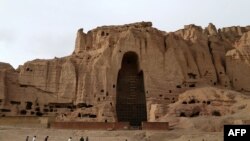When Dadali walks past the site where Afghanistan's ancient Bamiyan Buddhas once stood, his "heart bleeds" -- which is understandable, considering he helped destroy them.
Over the course of three weeks in the spring of 2001, Dadali was forced by the Taliban to take part in the effort to turn the towering statues into rubble. Merza Hussain, a Hazara who lived in a rock cave between the two Buddhas, was there, too, as were dozens of other locals.
The 53-meter Solsol and the 35-meter Shahmama had stood for at least 1,500 years, and were a testament to Afghanistan's pre-Islamic history. But the rise of the Taliban and its fundamentalist brand of Islam left them vulnerable. The militant group branded the two Buddhist monuments as "idols" that Muslims had a duty to destroy, and in 2001 Taliban leader Mullah Mohammad Omar ordered their demolition.
Chipping Away
As the world looked on helplessly, the Taliban initially struggled to demolish the Buddhist monuments carved into the sandstone cliffs overlooking the Bamiyan Valley. But that was before locals were brought in to help.
Hussain says he and other Hazaras, a Shi'ite ethnic minority that the Taliban accused of worshipping Buddha, had been detained by the militant group. Eventually he was employed to take part in the demolition, which he says was overseen by foreigners who spoke "Arabic, or perhaps Chechen."
Dadali, who was in his early 30s, also wasn't a willing participant in the destruction. The farmer and some 80 other men from nearby villages were rounded up and put to work after the Taliban's tank and artillery shelling failed to do the job.
"They took us to the top of the hill and told us to tie the ropes around our bodies and slide down," Dadali recalls. "I told them that I couldn't do it, because it was too dangerous and I was too afraid, but they told me they would push me off the cliff if I refused."
He was horrified when he saw two men die -- one who fell to his death while rappelling down and another shot dead for refusing to try -- but Dadali was left with no choice but to do what he was told. "We would dangle from ropes to dig holes in the statues and plant explosives," he says, estimating that the entire process took about 25 days.
Eventually, Solsol and Shahmama were gone, and only mounds of debris and gigantic cavities in the rock remained.
Cause For Celebration
When is was all over the Taliban had a lavish feast. "They slaughtered nine cows in front of us," Hussain says. "Then they started celebrating the destruction of the statues -- dancing, clapping, and shooting into the air."
For him, the loss literally hit home. Ongoing war and poverty had left him and his family homeless, and they had sought refuge among the hundreds of caves created by Buddhist monks near the statues.
Hussain regrets his role in the destruction of the Buddhas, but has rebuilt his life and now runs a bicycle-repair shop in Bamiyan.
Dadali, now 45, says his "heart bleeds" when he sees the remains of the Buddhas.
Afghan authorities, along with the UN's cultural agency, UNESCO, plan to reconstruct the Buddhas, but Dadali does not expect to be around to see it.
He has decided to leave Bamiyan to start a new life in Kabul, even though he knows the memory of destroying the monuments will "haunt" him wherever he goes.





